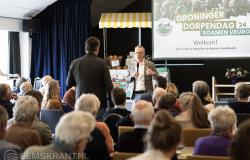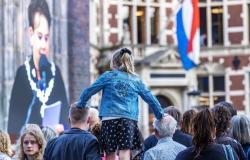
Anyone who regularly drives along the northern Ring Road past the Zernike Campus has seen the building risen in recent years: the brand new Feringa Building. Dagblad van het Noorden took a look at the building.
Professor Wesley Browne is in a hurry. It is Thursday morning, he has to take an exam and he is busy moving his team from the old Nijenborgh 4 to the new Feringa Building. “We have six days to move,” he says, striding his way down the hallway. “We have about 200 boxes, 30 crates and various equipment that need to be unpacked. And we have to figure out where exactly we put everything.”
It’s just as much of a puzzle as moving yourself. Which kitchen cupboard do you use for the plates and what is a convenient place for the herbs? Although in this case you have to replace signs with lasers and herbs with chemicals.
Browne is part of the Stratingh Institute for Chemistry and specializes in finding solutions in the field of coatings. Think of ways to better protect steel against rust, for example. He does this with his team, using lasers. By shining a laser on molecules, they extract information from them. And yes, those lasers and all the components that go with them must be placed in one of the 35 laser labs in the new building. There is little visible of the lasers at the moment. It is mainly moving boxes, styrofoam granules and bubble wrap that decorate the lab.
Construction started in 2019 and should be completed in 2026
Construction of the Feringa Building started in 2019. The building, named after Nobel Prize winner Ben Feringa, will soon have 64,000 square meters, 3 kilometers of lab tables, 450 fume hoods, 35 laser labs, a lecture hall with 420 seats and a restaurant with 250 seats. It is 260 meters long, 63 meters wide and has five floors. Part of the Faculty of Science and Engineering, where many science subjects and technology disciplines are taught, is moving here.
The old building, a stone’s throw from the new one, is no longer suitable. It is worn out and not durable. “It’s old and finished,” concludes Browne. “And since it became known that a new building was being built, little has been done about it,” says PhD student Hugo den Besten, who works with Browne. “Then you get, for example, that a roller blind that breaks is no longer made.”
Which does not mean that the labs and the like in the old building all consist of old junk. Certainly not. “But the new research environments are in general much higher quality,” says housing manager Andrys Weitenberg. “The design and facilities are also a lot better.” In addition, the researchers in the Feringa Bulding have access to vibration-free floor fields and an enormous clean room, which makes research possible under special clean conditions.”
1400 students and 850 employees
Upon entering, you immediately notice the large atrium. Lectures and conferences can soon be held there. Below the atrium is a large lecture hall that can be divided in two if lectures are given to smaller groups. Light wooden stairs lead students up and down. Coffee corners and study areas have been created in the long corridors leading to the wings.
When completed, the Feringa Building will house approximately 1,400 students and 850 employees. The first lectures have already been given in the building and students are already working at the study places that have been created in various places in the long corridors.
Not without a fight
However, construction did not go without a hitch. In 2017, the tender came to a standstill because construction threatened to become much more expensive than expected. In 2019, the university was at a loss when three technical companies took the RUG to court because they alleged that the university had ignored procurement law.
A total of around 200 million euros has been budgeted for the construction. Various departments are moved from March to June. The reason why the new building has already been partly put into use is that part of the old building has to be demolished to make room for the last part of the Feringa Building.
“The demolition of part of Nijenborgh 4 (the old building) will start in June 2024,” says Weitenberg. “As soon as the demolition is complete, the final phase of the Feringa Building will be made there.” It should be completely finished in 2026.
Browne and his team have already been in their new place for a long time. For now it’s time to unpack.
Tags: laser labs square meters kilometers lab tables brand Feringa Building Groningen
-




